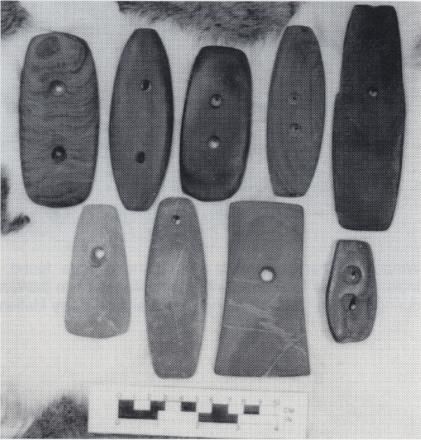Gorgets and Pendants, Stone Ornaments

By James Tharpe, Plainfield, Indiana
Gorgets at first glance take on a similar appearance in shape to that of the undrilled bar type bannerstone. This form of artifact can vary greatly in form, but yet be so similar that it is possible to pass from one of one type to another of absolutely different type by steps so gradual that the transition seems quite natural. In this attempt to describe a gorget no fixed line can be drawn separating them from pendants on one side and bannerstones on the other. Its derivative may be linked through or with the Late Archaic Glacial Kame Culture. What is known is that the gorget dates from the Late Archaic time and continued through the Mound Builder and Woodland Cultures. Therefore the gorget may have coexisted with some forms of the bannerstone.
The name gorget is derived from the word “gorge” or throat, because many of these artifacts are believed to have been worn at the throat or upon the chest. However early explorers saw the Miami Indians wearing the gorget fastened to the hair. Today some women wear a similar object as a hair decoration. Today they are made of leather with a large hairpin positioned through two holes of the leather piece, while another similar object is made entirely of plastic.
While banded slate was greatly used for gorget manufacturing, a variety of other materials were also used. Examples of these are soapstone, limestone, shell, and granite; however, granite was rarely used.
Besides the flat pendant type of gorget, the long, thick, bar-shaped gorget includes the perforations of two or more drilled holes.
Special notice has been taken in regards to the Adena and Hopewell gorgets for their overall contour and shapely design. Adena forms range from the expanded center, quadriconcave, bi-concave, rectangular and semi-keeled shapes. Hopewell ranges from rectangular, expanded center (a different form of the Adena), and boat-shaped.
The drilling process with the Adena and Hopewell culture is from one side, that being the flat surface. All other forms of the gorget generally are drilled from both sides with a common meeting in the center of the artifact. The drill would be made from flint for its hardness and durability while perforating a given stone. During the drilling process a cone taper shape occurs, finally reaching a point where the stone is breached from one side or the other. Occasionally an unfinished gorget is found without the boring of the holes and those that have only one hole are considered to be pendants. Pendants were worn about the neck much in the same manner as gorgets.
Observed on the edges of some pendants and gorgets are notched cut marks called tally marks. These marks are not regularly placed on the stone and are not thought of being just decorative. It is conjectural that this may have served as a record of events.
The boat-shaped gorget of the Hopewell Culture has a flat surface and a elevated convex upper surface although some types of this group may only have a slight convex. The drilling is from the flat surface until the stone is breached through. Often a slight chamfering of the hole was done from the upper or convex side. These gorgets tapered from an expanded center to either pointed or squared tips.
